Nationally Designated Important Cultural Property
Arakawa Residence Visit
Apr. May Jun. Jul. Aug. Sep. Oct. Nov. Dec. 2021 Inf.
October
October 9: Kanjiki (Snowshoes)
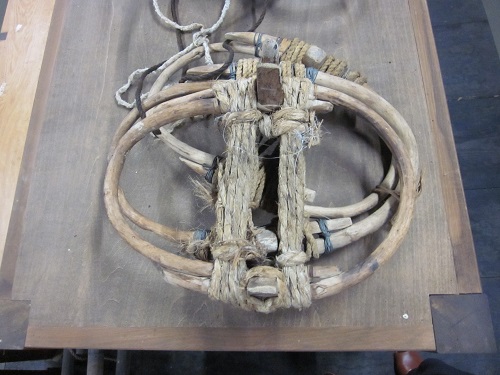 These are kanjiki (Snowshoes) that you put under your footwear so
that your feet do not get into the snow when walking on the snow.
These are kanjiki (Snowshoes) that you put under your footwear so
that your feet do not get into the snow when walking on the snow.
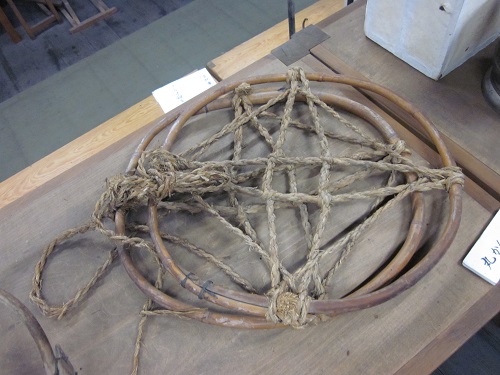 These are round-shaped Marukanjiki (Snowshoes).
These are round-shaped Marukanjiki (Snowshoes).
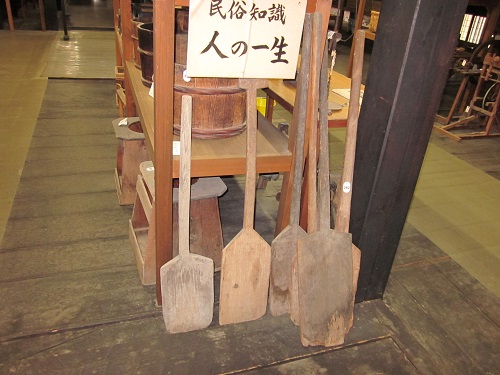 These are Banba made of wood for shoveling snow.
These are Banba made of wood for shoveling snow.
October 9th: Kotatsu
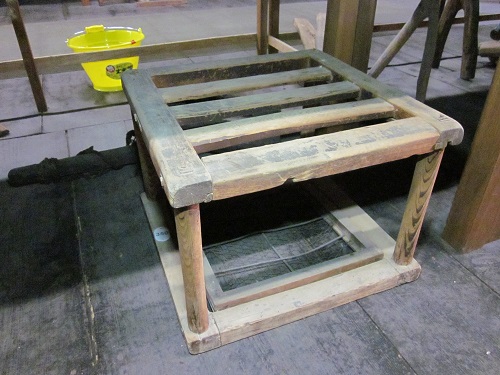 This is a Kotatsu that cuts the floor, makes a furnace, puts ash in it,
puts charcoal fire in it, puts a tower on top,
and puts a futon on it to keep warm.
This is a Kotatsu that cuts the floor, makes a furnace, puts ash in it,
puts charcoal fire in it, puts a tower on top,
and puts a futon on it to keep warm.
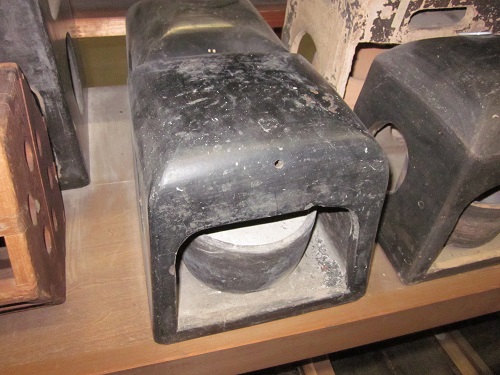 This is Banco for the bedroom that puts a bowl-shaped unglazed vessel
in a unglazed box, puts ash in it, puts charcoal fire in it,
puts a futon to keep warm.
This is Banco for the bedroom that puts a bowl-shaped unglazed vessel
in a unglazed box, puts ash in it, puts charcoal fire in it,
puts a futon to keep warm.
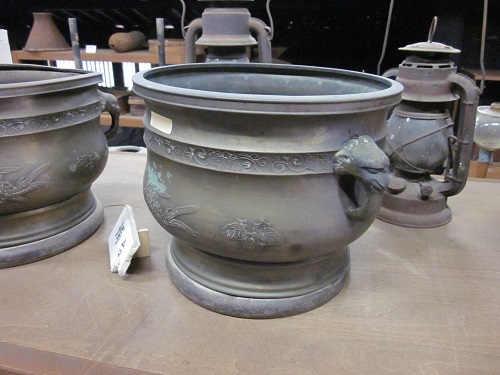 This is a metal brazier (Hibachi) that warms up in the room.
A charcoal fire was put on top of the ash in the brazier and burned.
This is a metal brazier (Hibachi) that warms up in the room.
A charcoal fire was put on top of the ash in the brazier and burned.
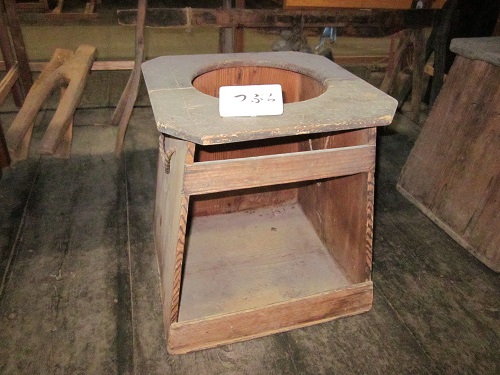 This is a Tachitsubra raised by putting an infant who was able to walk in it.
This is a Tachitsubra raised by putting an infant who was able to walk in it.
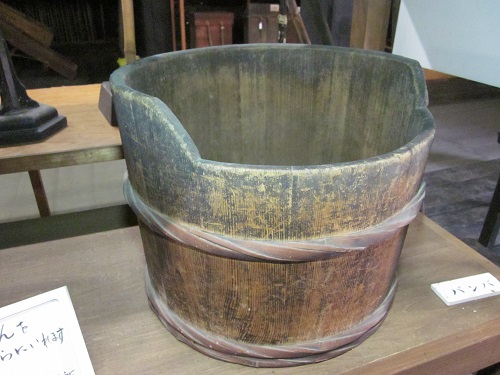 This is Oketsubura raised by putting an infant until it can walk.
This is Oketsubura raised by putting an infant until it can walk.
October 9th: Lamp
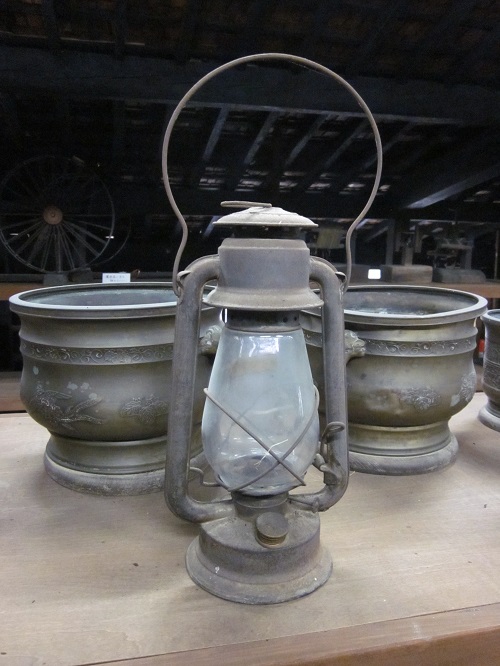 This is an oil lamp that puts oil in an oil jar and lights it.
This is an oil lamp that puts oil in an oil jar and lights it.
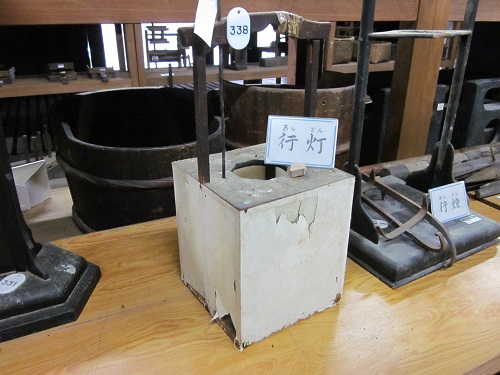 This is a lamp (Andon) that puts an oil pan inside and lights a fire.
This is a lamp (Andon) that puts an oil pan inside and lights a fire.
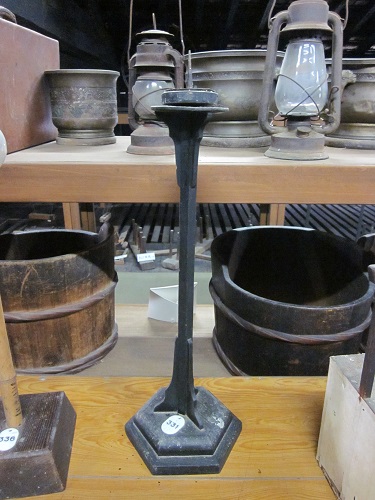 This is a candle holder. (Center)
This is a candle holder. (Center)
October 9th: Daihachiguruma
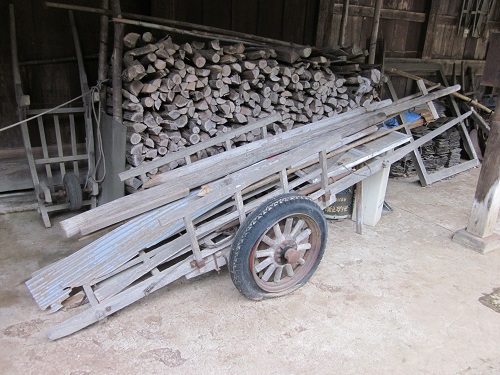 This is Daihachiguruma (large two-wheeled wagon) that carries baggage.
This is Daihachiguruma (large two-wheeled wagon) that carries baggage.
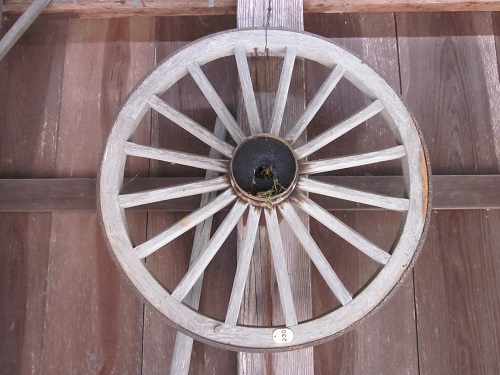 This is a wooden wheel of Daihachiguruma.
This is a wooden wheel of Daihachiguruma.
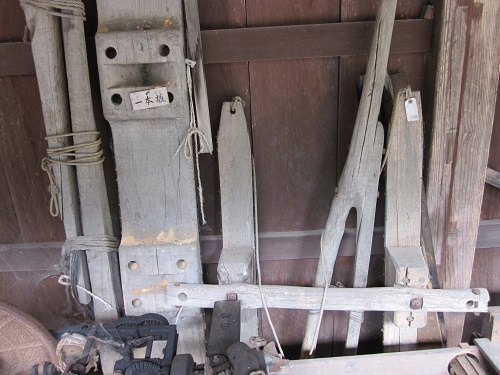 These are sleds that slides on the snow and carries baggage.
These are sleds that slides on the snow and carries baggage.
October 9th: Saw
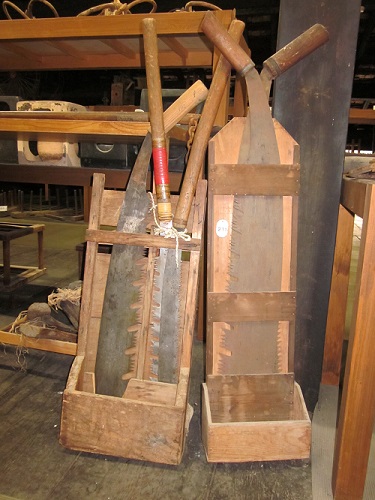 These are Menukinoko (saw) that cut large timber.
These are Menukinoko (saw) that cut large timber.
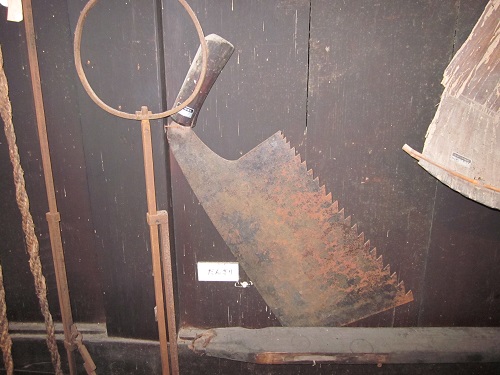 This is a Kobikinoko (saw) used when taking a board from a large tree.
This is a Kobikinoko (saw) used when taking a board from a large tree.
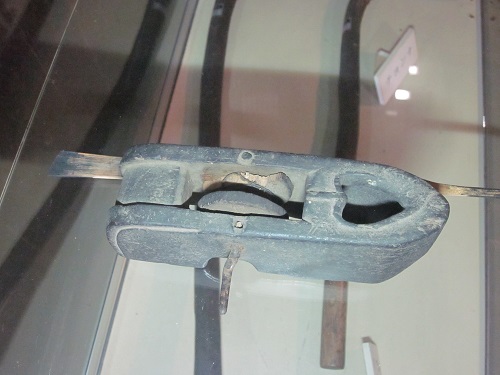 This is Sumitsubo that draws a straight line on the timber.
This is Sumitsubo that draws a straight line on the timber.
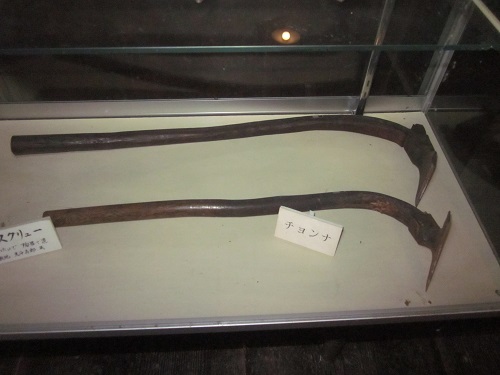 This is a chona that rough-cuts square timber.
This is a chona that rough-cuts square timber.
October 2nd: History and Folklore Museum
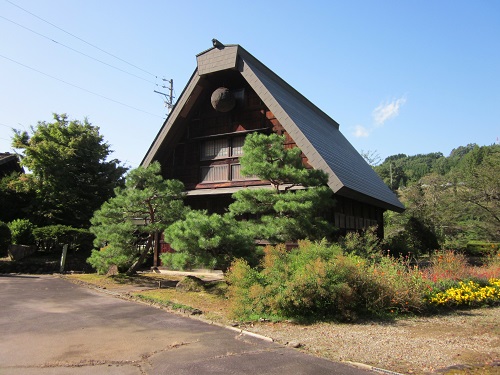 This is a History and Folklore Museum of a building
that imitates Gassho style.
This is a History and Folklore Museum of a building
that imitates Gassho style.
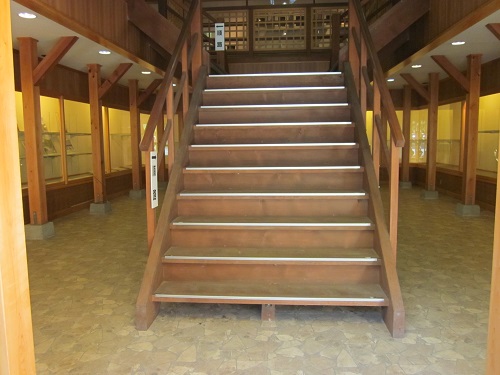 This is indoors of the History and Folklore Museum.
This is indoors of the History and Folklore Museum.
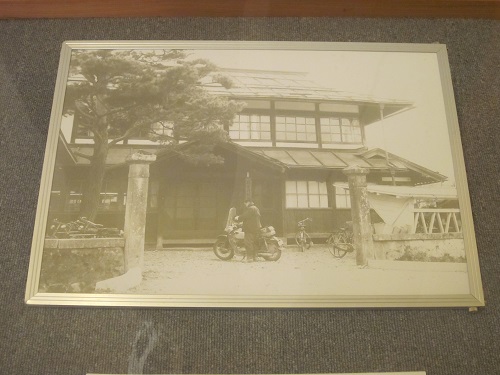 This is a photograph of the first government building of Nyukawa Village,
which was built in Meiji 32 (1899).
This is a photograph of the first government building of Nyukawa Village,
which was built in Meiji 32 (1899).
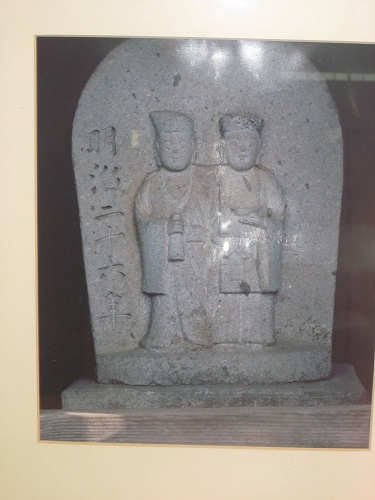 Pictures of Dososhin enshrined in Nyukawa Village are on display.
Pictures of Dososhin enshrined in Nyukawa Village are on display.
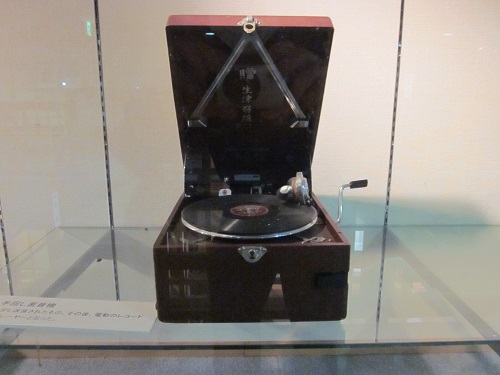 This is a hand-cranked phonograph.
This is a hand-cranked phonograph.
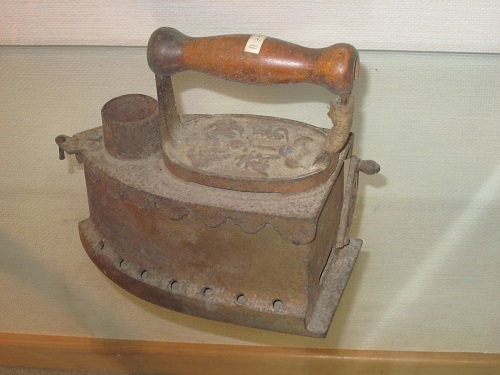 This is a charcoal iron.
This is a charcoal iron.
They put a charcoal fire inside and used it as a heat source.
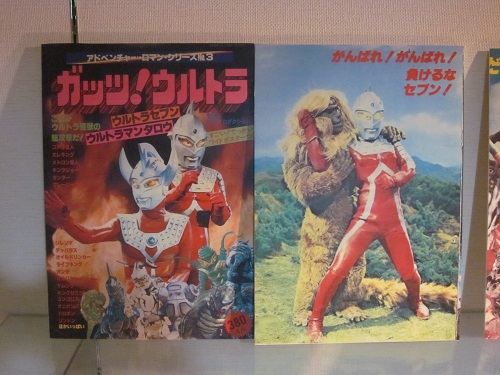 Paintings of Ultraman are on display.
Paintings of Ultraman are on display.
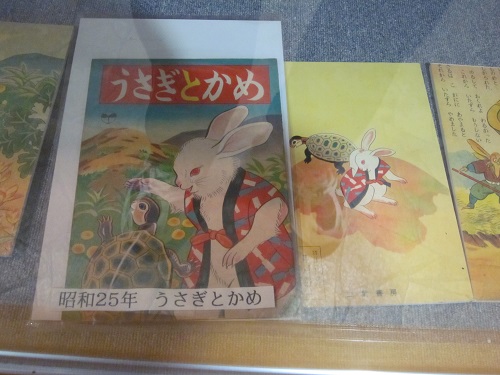 Picture books of fairy tales are on display.
Picture books of fairy tales are on display.
October 2nd: Straw rope (Waranawa)
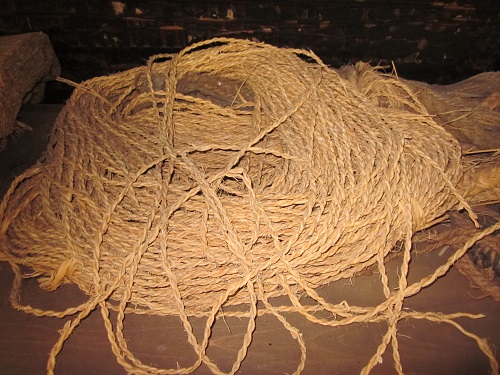 These are thin straw rope (Waranawa) made of straw.
These are thin straw rope (Waranawa) made of straw.
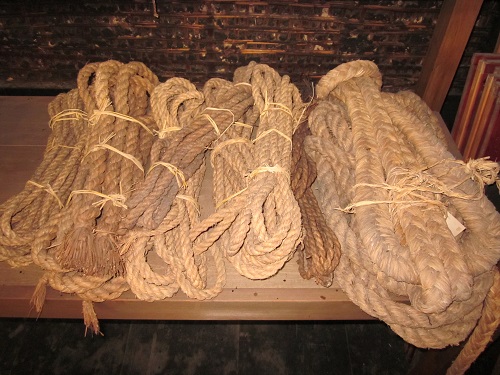 These are thick straw rope.
These are thick straw rope.
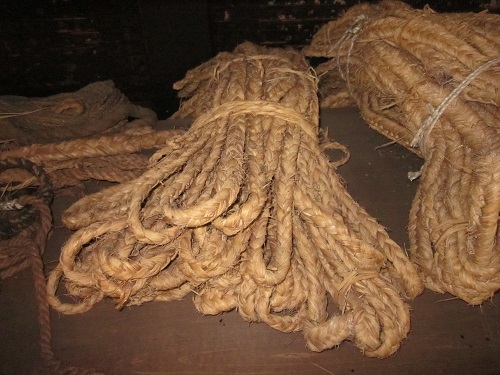 These are braided straw rope.
These are braided straw rope.
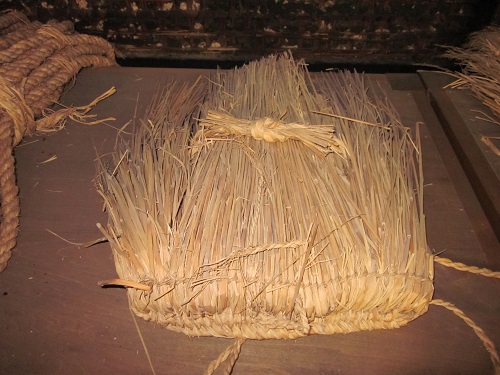 This is a Semino that is used as a cushion
when carrying heavy things on the back.
This is a Semino that is used as a cushion
when carrying heavy things on the back.
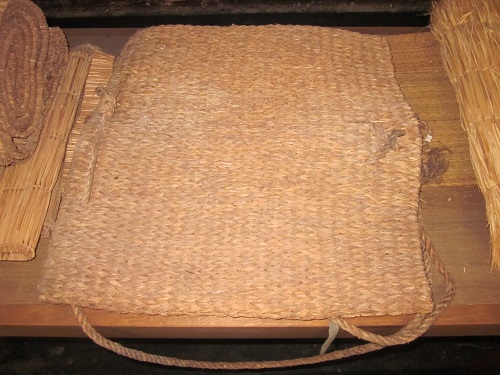 This is a Nekoda that carries a box lunch, work tools, etc. on your back.
This is a Nekoda that carries a box lunch, work tools, etc. on your back.
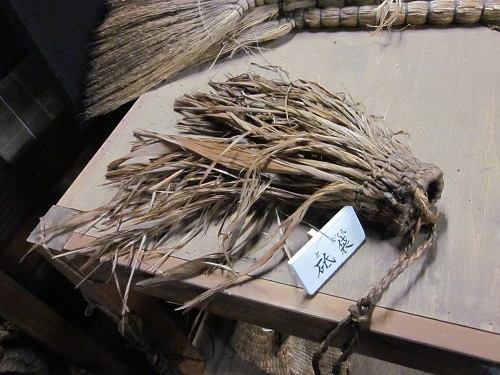 This is Tobukuro that puts a whetstone for sharpening
blades such as a sickle and attaches it to the waist.
This is Tobukuro that puts a whetstone for sharpening
blades such as a sickle and attaches it to the waist.
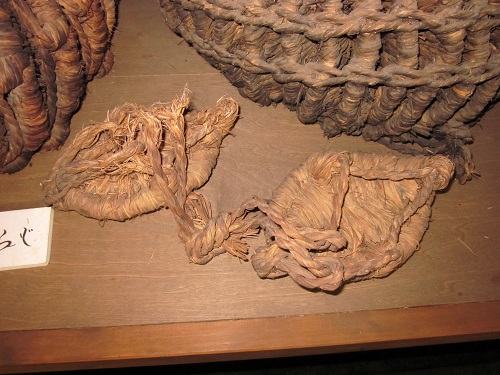 These are Waraji (straw sandals) to be worn on the horse's hoofs.
These are Waraji (straw sandals) to be worn on the horse's hoofs.
 These are Komo (straw mat).
These are Komo (straw mat).
October 2nd: Waraji (straw sandals)
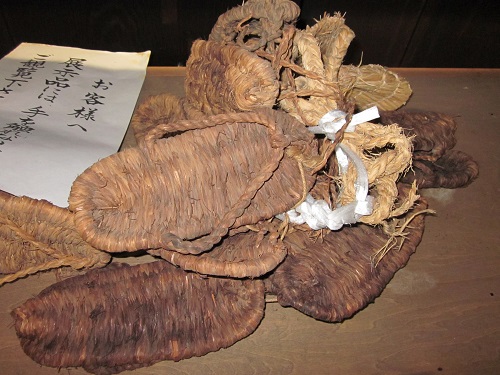 These are Warazori (straw sandals) made of straw.
These are Warazori (straw sandals) made of straw.
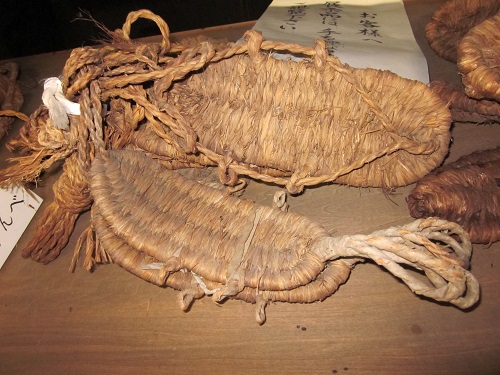 These are Waraji (straw sandals) made of straw.
These are Waraji (straw sandals) made of straw.
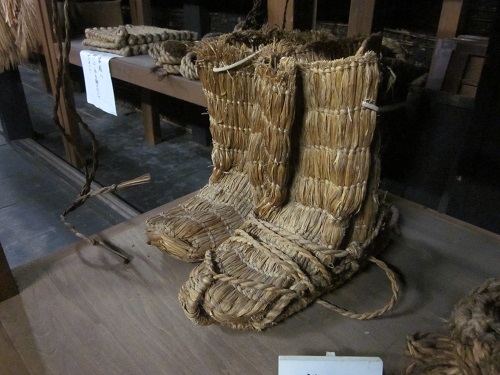 These are Zunbe (boots) made of straw, which is used in winter.
These are Zunbe (boots) made of straw, which is used in winter.
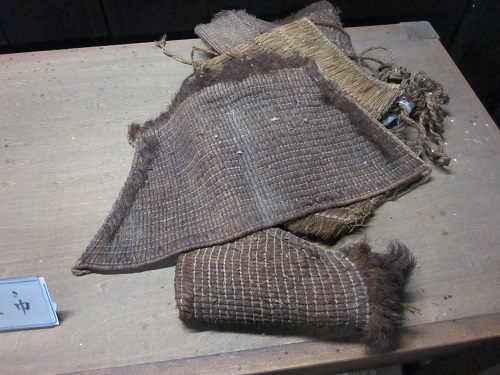 These are Habaki (leggings) that protect the shin by wrapping they around
the shin during snow or farm work.
These are Habaki (leggings) that protect the shin by wrapping they around
the shin during snow or farm work.
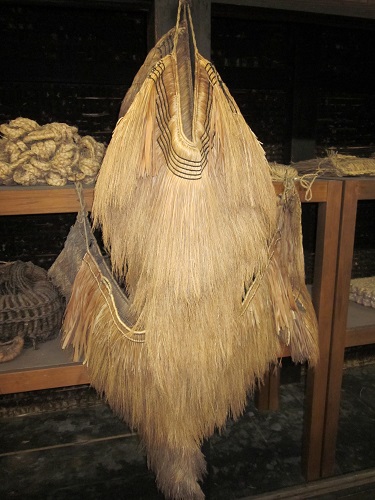 This is Bandori (rain wear) made of straw and linden bark.
This is Bandori (rain wear) made of straw and linden bark.
October 2nd: Tawara Amiki (straw bag making machine)
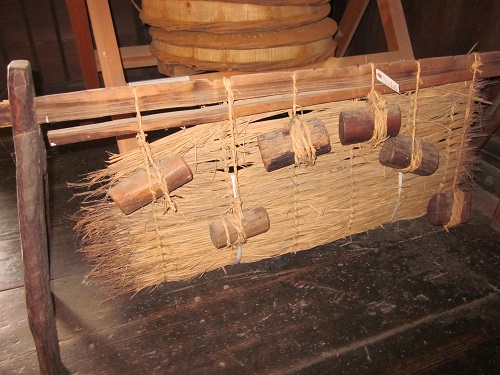 This is Tawara Amiki (straw bag making machine) that weave Tawara.
This is Tawara Amiki (straw bag making machine) that weave Tawara.
There are grooves in the crossbar supported by both legs,
and the warp are hung on them.
Some wooden weights (detchi) hang at the end of the rope.
Put straw between the warps and replace the weights back
and forth to weave.
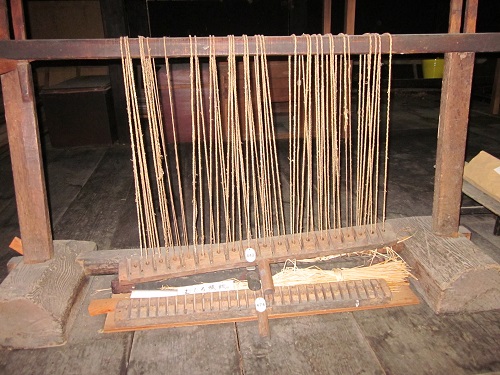 This is Mushiro oriki (straw mat loom) that weaves Mushiro (straw mats).
This is Mushiro oriki (straw mat loom) that weaves Mushiro (straw mats).
A large number of ropes are hung vertically on the upper crossbar.
The rope is passed through the hole in the Osa (reed).
When the handle in the center of the Osa (reed) is turned upward,
the rope will be divided into front and back every other time.
If they turn the handle downward, it will divide in the opposite direction.
When weaving Mushiro, first turn the handle of the Osa (reed) upward,
and between the front and back ropes,
straw is put in using a Sasu made of bamboo sticks.
Drop the Osa (reed) and tighten it.
Next, turn the handle of the Osa (reed) downward,
put straw between the ropes, drop the Osa (reed) and tighten it.
They will repeat this process and weave it.
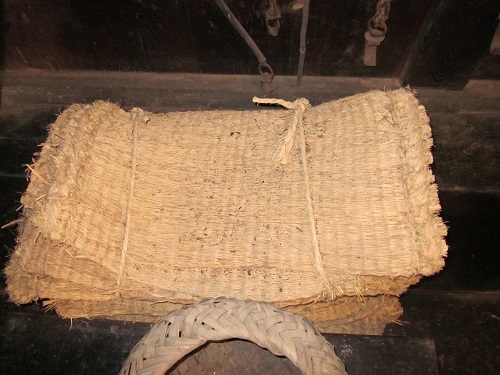 These are Kamasu that fold the Mushiro (straw mats) in two and bind both ends
with a rope to make a bag.
These are Kamasu that fold the Mushiro (straw mats) in two and bind both ends
with a rope to make a bag.
They put grain, salt, fertilizer, etc. in it.
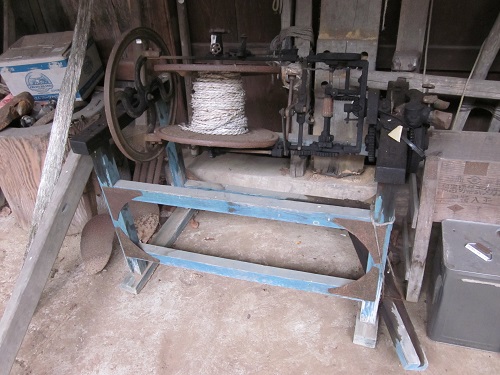 This is Nawanaiki (a straw rope making machine) that make Waranawa
(straw rope).
This is Nawanaiki (a straw rope making machine) that make Waranawa
(straw rope).
There are two mouths to put straws on the upper right side of
the wooden frame, and put the straw little by little here.
The straw that are put in are twined and are made rope.
The rope made is wound around the winding device on the left side.
The worker sits on the chair in front of the right end,
steps on the two pedals in front of the right end alternately,
and inserts the straw while rotating the entire upper device supported
by the wooden frame.
When the winding device is full of rope,
it is removed from the device and becomes a cylindrical finished product
with holes.
October 2nd: millstone (Isius)
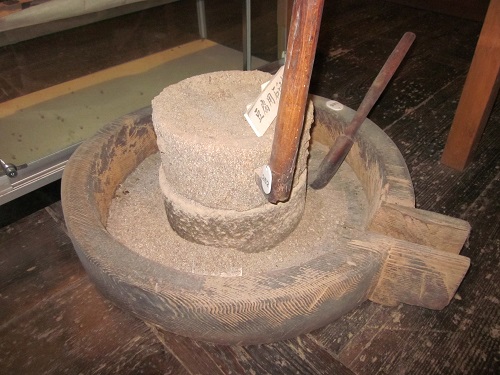 This is a millstone (Ishiusu) made of stone.
This is a millstone (Ishiusu) made of stone.
The millstone is a tool that grind grain into grain flour.
When grain is inserted from the hole in the upper millstone
and the upper millstone is rotated with a rod-shaped puller,
ground grain flour comes out from the lower circumference of the upper millstone.
Under the millstone is placed a millstone tub for tofu.
When making tofu, first soak it in water
and grind the softened soybeans with this millstone.
When thay grind it, white juice come out, so catch it in this tub
and transfer the juice from the groove to the container.
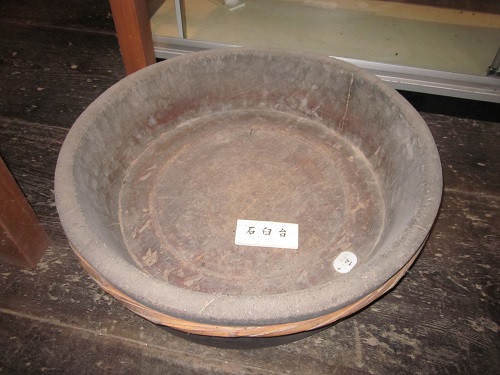 This is a stone mill stand (Ishiusudai) on which a stone mill is placed.
This is a stone mill stand (Ishiusudai) on which a stone mill is placed.
Grain flour from ground grain accumulated.
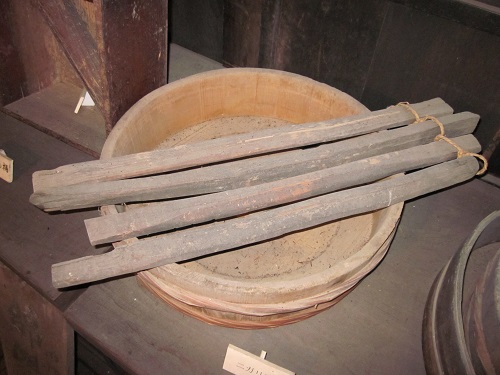 If you place unrefined salt placed in a Kamasu on sticks placed in a tub,
bittern drips and accumulates in the tub below.
If you place unrefined salt placed in a Kamasu on sticks placed in a tub,
bittern drips and accumulates in the tub below.
When making tofu, put this bittern in boiled soy milk and harden it.
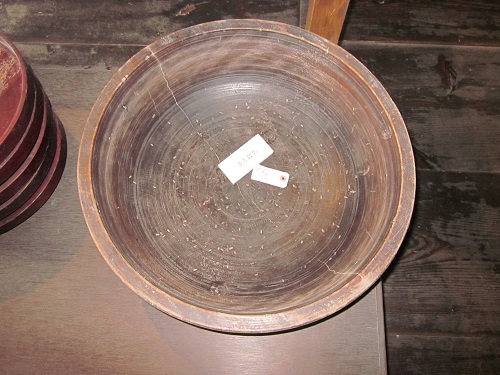 This is a wooden bowl (Kijibati) that kneads grain flour
when making dumplings.
This is a wooden bowl (Kijibati) that kneads grain flour
when making dumplings.
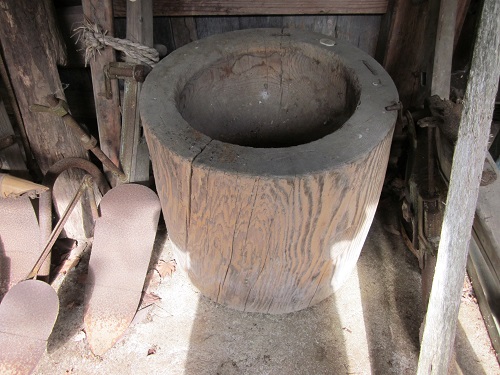 This is a wooden mortar (Usu) that pounds rice cake (Mochi).
This is a wooden mortar (Usu) that pounds rice cake (Mochi).
October 2nd: Beans drop
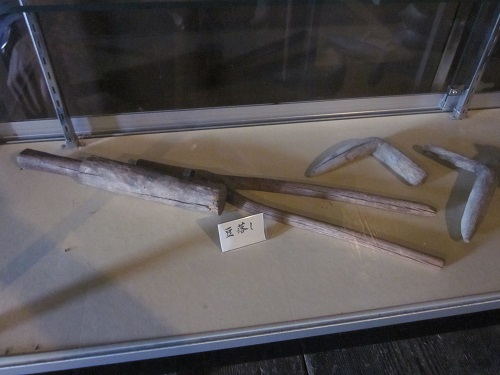 Soybeans, azuki beans, etc. are harvested from the roots,
dried on rice racks (Hasa),
and brought onto straw mats (Mushiro) that has been laid on the ground.
Hit the part of the pod with this bean-dropping mallets (Tsuchi)
to take out the beans from the pod.
Soybeans, azuki beans, etc. are harvested from the roots,
dried on rice racks (Hasa),
and brought onto straw mats (Mushiro) that has been laid on the ground.
Hit the part of the pod with this bean-dropping mallets (Tsuchi)
to take out the beans from the pod.
There are two types of bean-dropping mallets: wooden cylindrical and fork.
The L-shaped sticks on the right are bean planting sticks (Mameuebo).
The cylindrical part of this stick was grasped by hand,
the pointed end was pierced into the ground to make a hole,
and seed beans were put in it and covered with soil to sow.
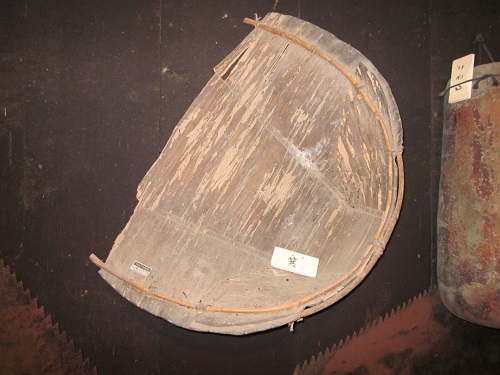 This is a winnow (Mi) using the epidermis of the linden.
This is a winnow (Mi) using the epidermis of the linden.
The seeds were put in and the dust was blown off by the wind.
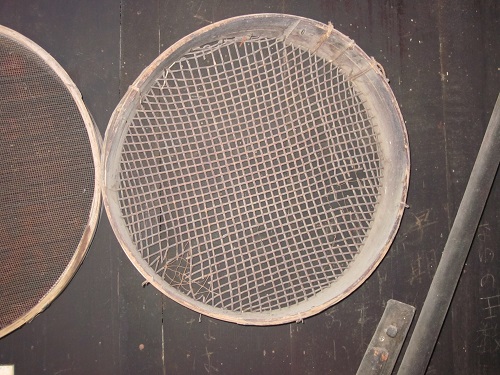 This is a sieve (furui) made of Sinomenium (Tsuzurafuji).
This is a sieve (furui) made of Sinomenium (Tsuzurafuji).
It was used to separate beans and dust.
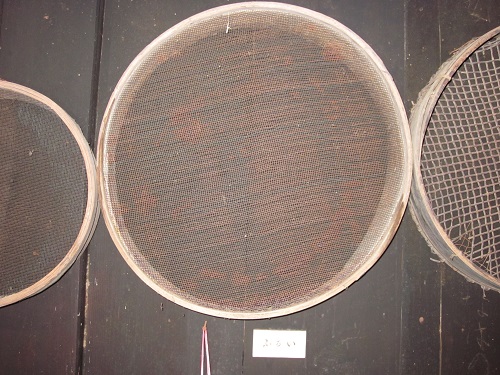 These are fine mesh sieves (furui).
These are fine mesh sieves (furui).
It was used to separate perillas (Aburae) and dust.
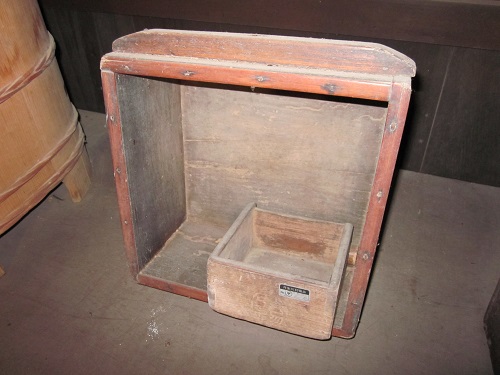 These are box (Masu) for measuring the capacity of grain etc.
These are box (Masu) for measuring the capacity of grain etc.
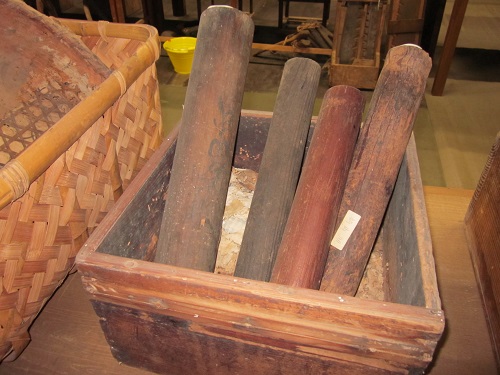 These are short rod-shaped Masukaki.
These are used to flatten the edges of grain piled on the box (Masu).
These are short rod-shaped Masukaki.
These are used to flatten the edges of grain piled on the box (Masu).
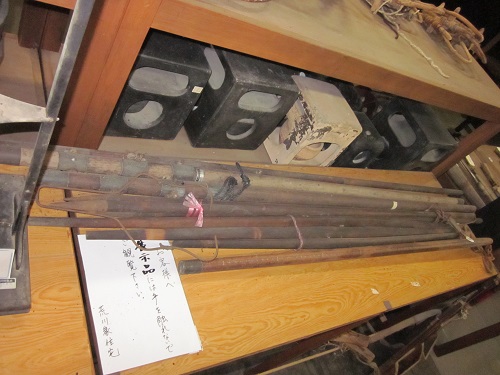 These are beam balance (Saobakari) that weigh.
These are beam balance (Saobakari) that weigh.
Put the object you want to measure on one end of the graduated beam,
move the weight so that the beam is horizontal,
read the scale at that position, and weigh it.
Back
<< Home < Back Next >